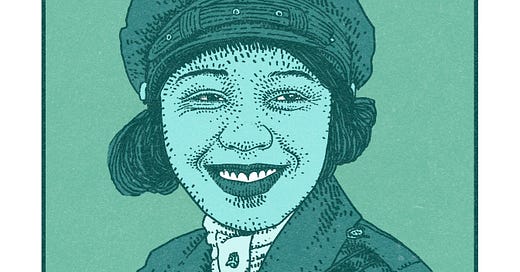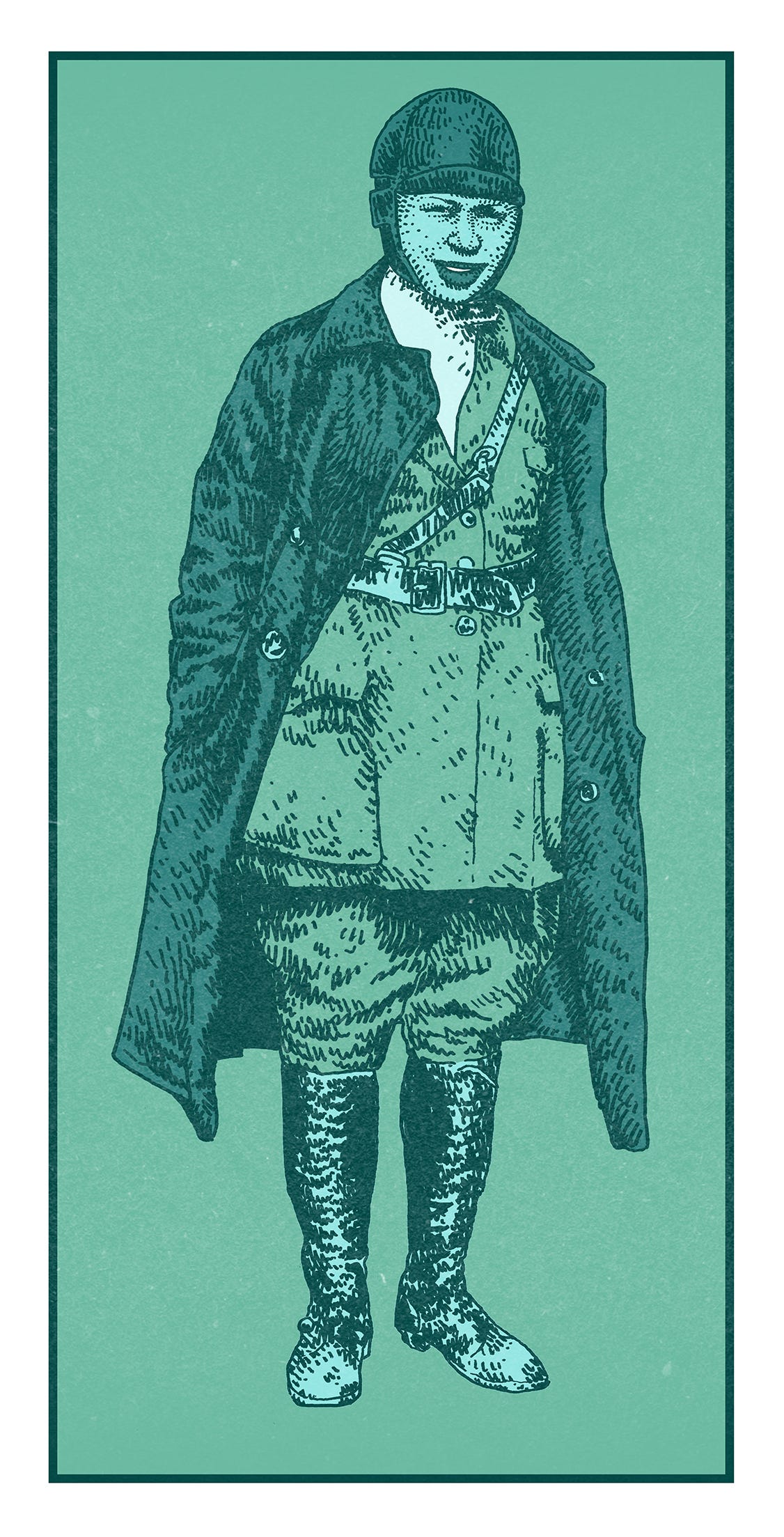Queen Bess
The enduring power of Bessie Coleman, the first Black woman to earn a pilot’s license
Welcome to Sports Stories, a publication at the intersection of sports and history: written by Eric Nusbaum, illustrated by Adam Villacin, and delivered to your inbox every Tuesday.
This month we’re covering early women in the history of aviation. If you’re not already a subscriber, please sign up here—it’s free!
Bessie Coleman was born and raised amidst the cotton fields of rural Texas. She died in Jacksonville, Florida in a haunting and brutal accident. As I have sat this week with the remarkable facts and impossible mysteries of Bessie Coleman, I have found myself at something of a loss—unable to get a good grip on the scale of her life: well-documented and yet unknowable, and tragic for reasons that extend beyond her early death.
Bessie’s father left the family when she was very young. He was part Native American, and thought he could find a better life in Indian Territory. Bessie was destined to leave Texas, too. But it’s better not to put it that way. The word destiny implies that there was some greater hand controlling Bessie’s life. But Bessie Coleman was not the type to leave her fate in the hands of anyone else.
When she was 23, she followed two of her older brothers to Chicago. It was 1915, the early days of the Great Migration. By all accounts, Bessie was ambitious and self-possessed and beautiful and brilliant. Sure, there were global, national, and local forces beyond her power, shaping her choices, shutting some doors and opening others. But history doesn’t just happen to people.
There is some inexplicable and specific human element that causes all of us as people to do the things we do. Flannery O’Connor called it the “mystery of personality.”
I lent some stories to a country lady who lives down the road from me, and when she returned them, she said, “Well, them stories just gone and shown you how some folks would do,” and I thought to myself that that was right; when you write stories, you have to be content to start exactly there—showing how some specific folks will do, will do in spite of everything.
This is a concept I think a lot about when writing history. No matter how hard we hit the archives or the books, it’s impossible to fully access and understand how some folks would do.
In this newsletter, we have a tendency to cover lives that skip like stones across history; lives that rhyme with global events, or take on some symbolic significance that grows with the passage of time. It’s a good trick writers use. If we’re good at this, the individual story becomes a vessel through which we can tell a much bigger and broader story.
The truth is, the biographical details of Bessie’s life have been covered over and over and over. In dozens of books for adults and children. In a documentary film. In one of those recent New York Times obituaries for overlooked historical figures. She’s even been honored on a postage stamp.
It would be possible for me to tell the story of how Bessie Coleman became the first Black woman to earn a pilot’s license as simply the product of a fearless, plucky personality meeting a peculiar historical moment. But this version of events would omit the ongoing tragedy of racism in America that made the mystery of Bessie’s personality so resonant—and still does; it would undersell the outrageous ambition and imagination that must have animated her.
Bessie worked as a manicurist in Chicago. During World War I, she was taken with the exploits of flying aces. Aviation was new and the stories captured her imagination. She read about the war every week in the Chicago Defender, the city’s iconic paper—in part because her brothers John and Walter were serving in France as part of the 370th Infantry. Both brothers survived the war, and when they returned, John would go on and on about how superior French women were to Americans. “They even fly airplanes,” he would tell Bessie.
Finally, Bessie had enough. She decided she’d do it, she’d learn to fly a plane herself. This was not an easy task for a Black woman in America in 1920. In fact, it was almost unimaginable. Doris Rich, one of Bessie’s biographers, put it succinctly:
“Black aviators couldn’t teach her because there weren’t any, and white aviators wouldn’t.”
The only way Bessie would be able to learn to fly would be if she traveled to Europe. France was leading the world in aviation, and according to her brothers it was a more enlightened place when it came to race. Bessie enrolled in language school. She convinced Robert S. Abbott, the publisher of the Defender to help sponsor her travel. (Abbott was a fascinating man in his own right: singer, attorney, and builder of a publishing empire that advocated fiercely for civil rights; he was also an early convert to and advocate of the BaHa'i Faith.)
Bessie traveled to France in 1921 aboard a ship called the SS Imperator. Its captain was a fellow named Arthur Rostron, who had become briefly famous a decade earlier as the captain of the RMS Carpathia, the ship that came to the rescue of Titanic survivors in the icy Atlantic.
In France, Bessie walked nine miles each day from her room to her flight school. She witnessed a fatal crash. Barely able to understand her instructor between the language barrier and the roar of the engine, she learned to fly by watching the controls. And in June 1921, she achieved her license from the Federation Aeronautique Internationale.
When Bessie returned to the United States it was as a celebrity, especially in the Black press. The reporters were waiting for her as she got off the boat. She immediately embarked on a career as a barnstorming pilot drawing crowds to airshows across the country. She was funny. She was fearless. Simply becoming a pilot was not enough: Bessie wanted to entertain and she wanted to empower. She was intensely aware of her own symbolic importance, but she was not content to leave it at that:
Here’s the New York Times:
She dazzled spectators by walking on the wings while aloft or parachuting from the plane while a co-pilot took the controls. Her stunts were widely covered in the press, especially in black newspapers, and she cut a glamorous figure.
She enjoyed the attention so much that she decided to try acting and was cast as the lead in a film based on her life story. But she turned down the part after learning that the movie began with her character appearing in rags, which she found demeaning and undignified. “No Uncle Tom stuff for me!” she told Billboard magazine.
Bessie survived a bad crash in California—and the crash itself became a part of her legacy, something she would talk about with the press and with her crowds. She insisted on integrated seating at her air shows in the segregated south. She was so popular that at a Juneteenth celebration in 1925 meant to be for an all-Black crowd in Houston, organizers had to add a section for white audiences that were clamoring to see her. After the show, she and her fellow pilots took spectators up for rides—a rare opportunity in the time and place.
Bessie dreamed of opening a flight school for Black pilots. The conditions that had made it so hard for her to get her license persisted in America. She eased up on the risky demonstrations in favor of the lecture circuit. But she needed to get the money together. Even as a groundbreaking celebrity pilot, she was still a Black woman in a hard and unforgiving country. A flight school would be no easy task. It would be expensive. And so Bessie accepted an invitation to fly in an air show in Florida.
This was how she ended up in Jacksonville in 1926. There is obviously so much we don’t know about the circumstances. We don’t know what Bessie was thinking. We don’t know whether she was tired and dreading this gig or whether she was exhilarated to be doing the thing she loved—the thing that made so many people love her.
On April 30, the day before her scheduled demonstration, Bessie and her co-pilot, a white man named William Willis took off to scout the territory around the grounds and test out their new plane. This was important because Bessie would be leaping out with her parachute—they needed to find a good spot to execute the jump. Bessie unstrapped her seatbelt so she could look down over the edge of the cockpit and scan the earth below.
She was doing exactly this when the plane sputtered and coughed and jerked out of Willis’s control, nose-diving and finally flipping upside down. Bessie fell 500 feet and died on impact. Willis was not able to recover control of the plane, and it crashed into the ground, trapping him—still alive—under the wreckage. Rescuers soon arrived on the scene. But in a panic, one of them lit a cigarette. The plane burst into flames. Willis died in the fire. Later, investigators found that a loose wrench had been left in the engine before takeoff.
Bessie Coleman was 34 years old. Ten thousand people came to mourn her in Chicago. The legendary journalist and civil rights leader Ida B. Wells officiated her funeral.
I come back now to the mystery of personality. In this newsletter, I do a lot of biography: I sum up a life and stick to the good parts; I speed time up and slow it down and linger in the conflicts, and the action, and the places where the narrative serves some broader argument I might want to make. This is manipulation and it is always, on some level, insufficient. Every life is worth more than we can give it in this space.
Bessie Coleman’s life has been written about more than most of the people we’ve covered here. And yet for all the words I can’t help but wish I could understand what drove her to get on that boat to France, to get on that airplane in Jacksonville. I can’t help but wish I could do more than skim the surface.
Related Reading
The New York Times “Overlooked No More” obituary of Bessie Coleman is a nice place to start for a good overview. It relies on Doris Rich’s book Queen Bess: Daredevil Aviator — which is really impressively researched. There’s also some really fascinating (but academic) stuff in this book Performing Flight: From Barnstormers to Space Tourism by Scott Magelssen.
Also: here’s a link to the Flannery O’Connor essay I referenced above. Thanks to the kind soul who scanned the PDF and posted it on the internet.
Etc.
A few weeks ago, in our issue on Maria Tallchief, I wrote about my mistaken belief that Michael Jordan was awesome at basketball because he did ballet. Well, here’s a story about the awesome Uruguayan soccer player Edinson Cavani getting ahead on the pitch by … doing ballet.
Sports Stories is almost at 100 paid subscribers. If you have the means, please help us get there! Subscriptions start at just $5/month — and come with a set of awesome postcards featuring Adam’s illustrations.
Stealing Home comes out in paperback next week. The book, like this newsletter, features words by Eric and some beautiful illustrations by Adam. Pick it up from your local bookstore, or right here.
Thank you for reading Sports Stories. We’ll see you next week with more tales of aviation.





